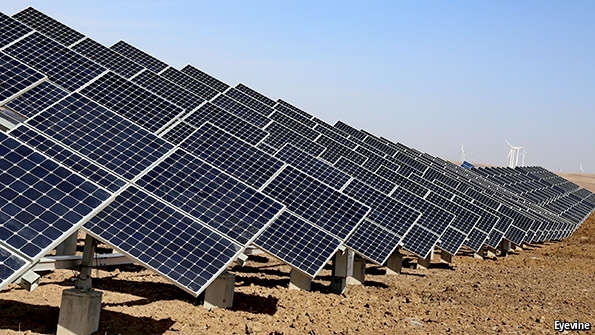
How renewable energy can
become competitive
Solar technology has already made significant progress in a short amount of time. Renewable power is gaining market share against other sources, especially in sunny and spacious places, and where other fuels are scarce or dirty. For solar, as one might expect, sun-drenched locations are the most competitive ones; California and Hawaii are trailblazers). Open, spare tracts of land (or sea) are better for the economics of wind power. Tax breaks help too: such as the 30% investment credit that Americans get for installing renewable capacity, for example the booming business of rooftop solar panels. Another subsidy is available to households that are able to sell surplus electricity to the energy company at favourable prices (such as the tariff paid for the electricity the company sells its customers). This is called “net metering” in America and in effect uses the grid—the poles, wires and generating capacity paid for by other consumers—as free storage.
Yet opponents of renewables say the level of subsidies involved shows that wind and solar investments are just boondoggles, salving the conscience of the green-minded and cossetting politically connected companies. That is true up to a point—governments have probably spent too much money on first-generation technology which is inefficient and expensive compared with what is now becoming available. But all energy is subsidised one way or another; users of fossil fuels don’t pay for the damage they do to the planet. Subsidies to renewable energy are around $100 billion a year. A recent IMF working paper estimated the subsidies to fossil fuels (including the uncompensated costs of air pollution, congestion and global warming) at $5.3 trillion. Perhaps more important, subsidies for renewables are dropping (at least on a per watt basis); America’s tax credit is being cut, and Britain is ending subsidies for onshore wind. Meanwhile renewables’ efficiency is rising fast. Unsurprisingly, renewable use is growing dramatically. According to the International Energy Agency (an energy agency created by the OECD, a club of mostly rich countries) renewables accounted for almost 22% of global electricity generation in 2013, a 5% increase from 2012. China and India are investing heavily in renewables (China, notably, in wind). Wind used to be the cheapest, but solar is now overtaking it in most markets. That trend will continue. Almost any external surface can generate solar electricity, and costs are plummeting (not just for the silicon wafers, but also for installation, electronics and storage needed to make the system work). Wind energy is getting cheaper too, with taller windmills erected more cheaply—but the potential gains are less dramatic.
For renewables to play a meaningful role in slowing climate change, however, will require much more progress, much faster. The authors behind the Apollo project note that atmospheric carbon-dioxide levels are on track to reach a level in 2035 in which a rise in global temperatures of 2°C is highly probable (and temperature will keep rising, by 4°C, if policies do not change). To head off that dangerous possibility renewables will need to be cheaper than fossil fuels by 2025. That, in turn, would require technological breakthroughs in the near future—and much more research and development spending in the present. A carbon price might help, by making dirty fuels more expensive and encouraging private investment in renewables. At present private R&D expenditure in renewables industries is pitifully low: at just 2% of sales (the figure in pharmaceuticals is 5% and in consumer electronics 15%). Yet it was government research funding that got America to the moon in just a few short years. It stands to reason that another government boost will be necessary to make the world fully reliant on the sun.
